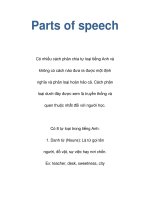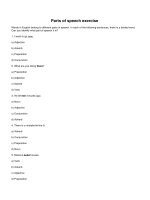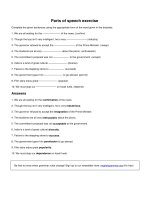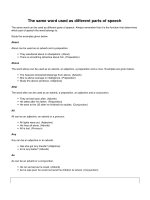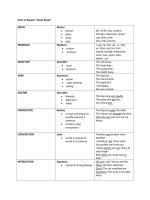parts of speech
Bạn đang xem bản rút gọn của tài liệu. Xem và tải ngay bản đầy đủ của tài liệu tại đây (2.67 MB, 39 trang )
parts of speech
house
yawning
she
pink
noun
verb
pronoun
adjective
an
softly
with
hey!
article
adverb
preposition
interjection
Table of Contents
Parts of Speech
Nouns
Verbs
Proper Nouns
Pronouns *
Abstract Nouns #1
Abstract Nouns #2 *
Abstract Nouns #3 *
Action Verbs *
The Verb "To Be" *
Finding Verbs *
Adjectives
Adjectives - Article/Determiner *
Comparative and Superlative Adjectives *
Adverbs
Prepositions *
Desk Prepositions *
Conjunctions *
Interjections
Word Research: Multiple Meanings
Parts of Speech Flash Cards
Word Research: Find a Noun that's Also a Verb
Certificate of Completion
Answer Sheets
* Has an Answer Sheet
Want more workbooks? Join Education.com Plus to save time and money.
/>Copyright © 2013 Education.com. All Rights Reserved
Nouns
A noun can be a person, a place, a thing or an idea.
Write in each box if the drawing is a person, place, thing or idea.
Now you try!
Write down your own examples below.
Person
Thing
Place
Idea
Copyright © 2013-2014 by Education.com
More worksheets at www.education.com/worksheets
Verbs
A verb is a word that shows acion or state of being.
Write a verb in the space to descibe the acion.
Copyright © 2013-2014 by Education.com
More worksheets at www.education.com/worksheets
Proper Nouns
All nouns fall under one of two categories: common or proper.
A proper noun is the name of a specific or unique item or
person, and proper nouns are always capitalized.
Directions: Follow the example below. Read the common noun.
Write a proper noun in the blank space beside it.
Common Noun
person
Proper Noun
Martin Luther King, Jr.
city
place
book
movie
restaurant
superhero
Copyright © 2013-2014 by Education.com
More worksheets at www.education.com/worksheets
Pronouns
A pronoun is a word that takes the place of a noun.
Here is a list of the most commonly used pronouns:
that
us
he
it
this
we
him
you
those
they
she
I
these
them
her
me
Let’s practice replacing nouns or proper nouns with pronouns.
Rewrite each sentence. Replace each underlined word(s) with the correct pronoun.
Bob walked to the store.
Sherri played ball with Anita and Roxy.
I didn’t expect the test to be hard.
Henry made dinner for Susan.
The baby cried all night.
Candy and I played basketball outside.
Copyright © 2013-2014 by Education.com
More worksheets at www.education.com/worksheets
Abstract Nouns
You know that nouns are persons, places, and things. Most of these nouns—
like the tree in your front yard, your dog, or your Aunt Betty— can be
seen, touched, heard, tasted or smelled. These are called concrete nouns.
But there are many things that you can’t see, touch, smell, hear or taste,
like love and happiness. These are called abstract nouns.
Directions: Write two sentences with at least ten words in each, using one
concrete and one abstract noun.
1.
2.
Now pick two of the abstract nouns you used. Describe each as if it were a physical object or a person.
Questions to ask yourself: If your abstract noun were a taste, what would it be?
What smell would it be? What would it look like? What would it sound like?
1.
2.
Copyright © 2013-2014 by Education.com
More worksheets at www.education.com/worksheets
Abstract Nouns
You know that nouns are persons, places, and things. Most of these nouns—
like the tree in your front yard, your dog, or your Aunt Betty— can be
seen, touched, heard, tasted or smelled. These are called concrete nouns.
But there are many things that you can’t see, touch, smell, hear or taste,
like anger and joy. These are called abstract nouns.
Directions: Is the noun something you can see, hear, touch, taste, or smell?
If not then it is abstract. Circle only the abstract nouns.
Example: The young girl had a childhood that was full of love and happiness.
1.
Lara had great trust for the police officer.
2.
Climbing that mountain took bravery.
3.
Mike shares lots of love with his family.
4.
The kitten had a fear of leaving her warm bed.
5.
He takes pride in his job.
6.
Pam felt a lot of anger when Tina moved away.
7.
The dove is a symbol of peace.
8.
My grandmother is full of wisdom.
9.
Connor has confidence that he'll make the team.
10. Ina is very tall for her age.
Copyright © 2013-2014 by Education.com
More worksheets at www.education.com/worksheets
Abstract Nouns
You know that nouns are persons, places, and things. Most of these nouns—
like the tree in your front yard, your dog, or your Aunt Betty — can be
seen, touched, heard, tasted or smelled. These are called concrete nouns.
But there are many things that you can’t see, touch, smell, hear or taste,
like love and happiness. These are called abstract nouns.
Directions: Underline the nouns. Then write them in the correct column.
f was that the rain would stop soon.
2. Devin felt great love for his grandfather.
3. Kate was in misery while she waited for the weekend.
4. Heidi's friends admired her beauty.
5. Ronnie has loyalty to only one football team.
6. Tanya's dream is to become a doctor.
7. Dad made a promise to play with us every day.
8. The science test gives Leo anxiety.
9. Mom told us many stories about her happy childhood.
10. Everyone saw Josh's determination to finish the race.
Abstract
Copyright © 2013-2014 by Education.com
Concrete
More worksheets at www.education.com/worksheets
Action Verbs
An acion verb is a word that shows acion;
it tells what someone or something is doing.
Circle the acion verb in each sentence.
Walter walked to the store.
He searched for the sports aisle.
Sue saw him there.
She walked over to him.
They chated for a while.
Then, Walter looked at his watch.
He shouted goodbye.
Finish this story using acion verbs.
Walter
to the bus.
He
his friends.
They
to him.
The boys
off the bus at the park.
They
ball for the rest of the aternoon.
Copyright © 2013-2014 by Education.com
More worksheets at www.education.com/worksheets
The Verb “To Be”
The verb “to be” is a litle different than acion verbs.
This verb shows state of being rather than acion.
Here are the different forms of the verb “to be”: is, are, am, was, were
Circle the “to be” verbs in the following sentences.
Sheila is ired.
The birds are on the roof.
We were late to the party.
I am hungry.
Kent was in a hurry.
Amy and I are best friends.
Now rewrite the sentences below.
Replace the “to be” verbs with more interesing verbs!
Copyright © 2013-2014 by Education.com
More worksheets at www.education.com/worksheets
Finding Verbs
You have probably heard that verbs are action words. And that is true.
But some verbs are more active than others.
Here’s an example:
Rosalind loves her pet rat, Sasha.
Where is the verb in that sentence? If you said loves, you would be right. Love isn’t an action that
we can see like runs or hits or jumps, but it is a verb just the same.
Part One: Finding Verbs
Read each sentence below. Find the verb and underline it, just like this:
Example: Rosalind loves her pet mouse, Sasha.
1. Rosalind feeds Sasha every day.
2. She knows everything about mice.
3. Mouse babies, like human babies, need a lot of sleep.
Hint: There is only one verb in this sentence. Think about how the word is used in the sentence
before deciding which word is the verb.)
4. Sasha waits patiently for her food.
5. She likes table scraps more than her own food.
6. Her cage stinks sometimes, especially on hot days.
7. Rosalind’s little sister Emma hates the smell and holds her nose.
Hint: There are two verbs in this sentence; they share the same subject.
8. Emma bothers Rosalind.
9. Rosalind knows that her sister is just teasing.
Hint: There are two verbs in this sentence; one of them is a helping verb.
10. Mice and other animals deserve care and respect.
Copyright © 2013-2014 by Education.com
More worksheets at www.education.com/worksheets
Finding Verbs
Part Two: Using Verbs in Sentences
Now it is time to write your own sentences using the verbs below. Make your sentences as
fun as you can by writing about something that interests you.
Your sentences need to have at least 10 words. That’s right, 10 words or more.
In the sentences you write, make sure you underline the verb you used.
Use one of the following forms of the verb “think” in a sentence: thinks, think, or thought.
1.
Use one of the following forms of the verb “need” in a sentence: need, needs, or needed.
2.
Use one of the following forms of the verb “hold” in a sentence: hold, holds, held.
3.
Use one of the following forms of the verb “deserve” in a sentence: deserve, deserves,
or deserved.
4.
Copyright © 2013-2014 by Education.com
More worksheets at www.education.com/worksheets
Adjecives
An adjective is a word that describes a noun.
Write three adjectives to describe each item.
Example:
pink
fluffy
prety
Copyright © 2013-2014 by Education.com
More worksheets at www.education.com/worksheets
Adjecives - Aricle/Determiner
An article (or determiner) is a special kind of adjective. It tells if the
noun is a general thing – an orange – or if it is a specific thing – the
orange. The three articles are: a, an, the
Circle the aricles/determiners in the sentence below.
The girl dreamt that she saw an elephant driving a bus.
Missing aricles/determiners are a common mistake, or typo, even for
experienced writers! That’s why all writers need an editor. Read the sentences
below and edit them by marking the missing aricles with an arrow. See the example.
an
I had soccer practice hour ago.
Mom stopped by store on her way home.
Thomas watched ant walk over his shoe.
I want to be astronaut when I grow up.
Pot roast tasted gross.
Hanna grabbed apple on her way to school.
We drove over old bridge.
I heard great song today.
Dad threw baseball over my head.
Jaime loves comic book store.
Copyright © 2013-2014 by Education.com
More worksheets at www.education.com/worksheets
A comparative adjective is used for comparing two people or things.
A superlative adjective is used for comparing one person or thing
with something else.
Adjecive: tall
Comparaive: taller
Ana’s cookie is
the
Superlaive: tallest
than her brother’s cookie, but their father took
cookie from the jar.
This book is
, but that book is the
Her hair is
than it was last year, and now it is the
of anyone in her class.
Mom makes
pancakes than Dad does, but Grandma makes the
of all.
It was
in Mrs. Clarke’s classroom than usual, but it felt the
in Mr. Hammond’s classroom.
Copyright © 2013-2014 by Education.com
More worksheets at www.education.com/worksheets
.
Adverbs
An adverb is similar to an adjective because it is a descriptive word. However,
adverbs do not modify nouns. An adverb describes a verb or an adjective.
Example of adverb describing a verb: Tom ran quickly.
Example of adverb describing an adjective: Tom’s shoes were bright blue.
Look at the pictures below. Write 3 adverbs to describe each verb so it matches the picture better.
run
eat
cry
sleep
Copyright © 2013-2014 by Education.com
yell
whisper
More worksheets at www.education.com/worksheets
Prepositions
A preposition links nouns, pronouns and phrases to other words in a sentence.
Here is a list of some commonly used prepositions:
of
in
to
with
on
at
from
by
as
into
like
after
over
between
against
during
without
before
under
around
Look at the scene below. Fill in the missing prepositions.
The dog is
the tree.
The ball is
the table.
The baby is
The clouds are
The cat is
Copyright © 2013-2014 by Education.com
her mother.
the sky.
the tree branches.
More worksheets at www.education.com/worksheets
Desk Prepositions
Mr. Cannon is trying to teach his class about prepositions! Prepositions describe a relationship
between other words in a sentence, telling about their location in time and/or place. Since they are
so tricky to learn, Mr. Cannon decided to use an old desk to show the students what he means.
Identify the preposition Mr. Cannon is demonstrating.
Copyright © 2013-2014 by Education.com
More worksheets at www.education.com/worksheets
List of Prepositions
Prepositions describe a relationship between other words in a sentence. There are around
150 prepositions in the English language. Here is a list of 70 of the most used prepositions.
aboard
besides
into
than
about
between
like
through
above
beyond
minus
to
across
but
near
toward
after
by
of
towards
against
concerning
off
under
along
considering
on
underneath
amid
despite
onto
unlike
among
down
opposite
until
anti
during
outside
up
around
except
over
upon
as
excepting
past
versus
at
excluding
per
via
before
following
plus
with
behind
for
regarding
within
below
from
round
without
beneath
in
save
beside
inside
since
Copyright © 2013-2014 by Education.com
More worksheets at www.education.com/worksheets
Conjunctions
A conjunction is a word that joins two words or two phrases together.
The most commonly used conjunctions are: and, but, or
Some other common conjunctions are : yet, for, nor, so
A conjunction can join two independent clauses (two sentences). Usually a comma is needed before
the conjunction.
Example: We need flour, sugar, butter, vanilla, an egg, and chocolate chips for the recipe.
A conjunction is often used at the end of a list. Sometimes a comma is needed before the conjunction.
This is called a serial comma, or Oxford comma. Not everyone uses the Oxford comma.
Example: We need flour, sugar, butter, vanilla, an egg, and chocolate chips for the recipe.
If you decide to use or not use an oxford comma, remember to stay consistent.
Read the sentences below. Circle the conjunctions.
Jake kicked the soccer ball too hard and it landed in the bleachers.
My mom and sister baked a cake for dessert.
I used noodles, tomato sauce, meatballs and cheese to make spaghetti.
The baby loved to dress up but loved wearing her tiara best.
Connor was not sure if he wanted eggs or waffles for breakfast.
Ray and I went to the library after school.
Sally wanted to play outside but it was too cold.
I went to the beach and surfed all day.
Copyright © 2013-2014 by Education.com
More worksheets at www.education.com/worksheets
Interjections
An interjection is a word that expresses an emotion or feeling. Interjections are
usually followed by an exclamation point, or in some cases a comma. There are
many different interjections, and even some that are made-up words!
Examples: Ouch! ; Oh no… ; Hey! ; Yikes!
Now it’s your turn! Look at each scene below. Write an interjection in the speech bubble.
A+
Copyright © 2013-2014 by Education.com
More worksheets at www.education.com/worksheets
Word Research: Multiple Meanings
Do you have a right to turn right? Do you know the right answer to that
question? Right is just one word that has many meanings. On this
worksheet you will learn more about this word with multiple meanings.
Use a dictionary to write down the definitions of the word: right.
Use right in 3 sentences. Each sentence should use a different meaning of right.
How are the different meanings of right similar?
Draw a picture that shows at least two meanings of the word right in action.
Copyright © 2013-2014 by Education.com
More worksheets at www.education.com/worksheets
Parts of Speech Flash Cards
Cut out the cards on the dotted lines. Fold the cards on the solid line. The word will be on the front and the
definition on the black. Glue or tape the flash card closed.
Interjections
An interjection is a word that
expresses an emotion or feeling.
Examples: Oh! Wow! Hey!
Prepositions
Prepositions are words that show
location in time and/or space.
Examples: near, under, above
Articles
An article is a type of adjective
that tells if a noun is a general
or a specific thing.
Examples: a, an, the
Conjunctions
A conjunction is a word that joins
two words or two phrases together.
Examples: and, but, or
Copyright © 2013-2014 by Education.com
More worksheets at www.education.com/worksheets
Parts of Speech Flash Cards
Cut out the cards on the dotted lines. Fold the cards on the solid line. The word will be on the front and the
definition on the black. Glue or tape the flash card closed.
Adjectives
An adjective is a word that
describes a noun.
Examples: blue, curly, shiny
Verbs
Adverbs
A verb is a word that shows
action or state of being.
Examples: run, jump, fall
An adverb describes a
verb or an adjective.
Examples: quickly, bright, quietly
A noun can be a person, a
place, a thing, or an idea.
Nouns
Copyright © 2013-2014 by Education.com
Examples: book, school, love
More worksheets at www.education.com/worksheets
